Solved Examples and Worksheet for Solving Quadratic Equations Graphically

A. 1 and -2
B. 2 and 8
C. -1 and 3
D. -1 and
Step: 1
From the figure, the graph intersects the x 3 2
Step: 2
The x 3 2
Step: 3
2x x
[Original equation]
Step: 4
2(-1)2 - (-1) = 3
[Substitute x
Step: 5
3 = 3
[Simplify.]
Step: 6
2( 3 2 3 2
[Substitute x 3 2
Step: 7
3 = 3
[Simplify.]
Step: 8
Both the values satisfy the equation. So, -1 and 3 2
Correct Answer is : -1 and 3 2
A. - 3 and 6
B. - 3 and 7
C. - 4 and 4
D. - 3 and 3
Step: 1
- 3x
[Original equation]
Step: 2
[Divide - 3 on each side]
Step: 3
[Subtract 9 from each side]
Step: 4
[Simplify.]
Step: 5
Sketch the graph of the related quadratic function y x
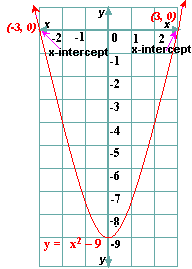

Step: 6
From the graph, the x
[Estimate the values of the x
Step: 7
So, - 3 and 3 are the solutions of the equation.
Correct Answer is : - 3 and 3
A. 9, 25
B. 11, 27
C. 8, 24
D. 10, 26
Step: 1
The area of a rectangle = length × width.
Step: 2
The area of the rectangular fountain = (a a
Step: 3
192 = (a a
[Original equation.]
Step: 4
192 = a a
[Use distributive property.]
Step: 5
192 + 82 = a a
[Add (16 2
Step: 6
256 = (a
[Write the right hand side as a perfect square and simplify.]
Step: 7
± 16 = a
[Evaluate square roots on both sides.]
Step: 8
± 16 - 8 = a
[Subtract 8 from each side.]
Step: 9
[Simplify.]
Step: 10
Width = a
[The dimensions cannot be negative.]
Step: 11
Length = (a
[Substitute 8 for a
Step: 12
The dimensions of the fountain are 8 meters wide and 24 meters long.
Correct Answer is : 8, 24
A. 16 cm, 28 cm
B. 14 cm, 26 cm
C. 15 cm, 27 cm
D. 13 cm, 25 cm
Step: 1
The area of a rectangle = length × width.
Step: 2
The area of the rectangular book = (a a
Step: 3
364 = (a a
[Original equation.]
Step: 4
364 = a a
[Use distributive property.]
Step: 5
364 + 62 = a a
[Add (12 2
Step: 6
400 = (a
[Write the right hand side as a perfect square and simplify.]
Step: 7
± 20 = (a
[Evaluate square roots on both sides.]
Step: 8
± 20 - 6 = a
[Subtract 6 from each side.]
Step: 9
[Simplify.]
Step: 10
Width = a
[Dimensions cannot be negative.]
Step: 11
Length = (a
[Substitute 14 for a
Step: 12
The book is 14 centimeters wide and 26 centimeters long.
Correct Answer is : 14 cm, 26 cm
A. 15 feet by 5 feet
B. 13 feet by 3 feet
C. 14 feet by 4 feet
D. 16 feet by 6 feet
Step: 1
The area of a rectangle = Length × Width
Step: 2
The area of the rectangular carpet = (a a
Step: 3
56 = (a a
[Original equation.]
Step: 4
56 = a a
[Use distributive property.]
Step: 5
56 + (- 5)2 = a a
[Add (- 10 2
Step: 6
81 = (a
[Write the right side of the equation as a perfect square and simplify.]
Step: 7
± 9 = (a
[Evaluate square roots on both sides.]
Step: 8
± 9 + 5 = a
[Add 5 on each side.]
Step: 9
[Simplify.]
Step: 10
Length of the rectangular carpet is a
[Dimensions cannot be negative.]
Step: 11
Width of the rectangular carpet is (a
[Repalce a
Step: 12
The dimensions of the carpet are 14 feet by 4 feet.
Correct Answer is : 14 feet by 4 feet
A. 3
B. + 9 and - 9
C. - 3 and 3
D. 7
Step: 1
[The equation in standard form.]
Step: 2
5x
[Original equation.]
Step: 3
5x
[Subtract 7 from each side.]
Step: 4
[Divide with 5 on both sides.]
Step: 5
[Subtract 9 from each side.]
Step: 6
Sketch the graph of the related quadratic function y x
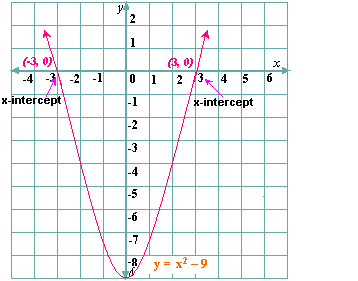

Step: 7
Estimate the values of the x x
Step: 8
By substituting x x x
Correct Answer is : - 3 and 3
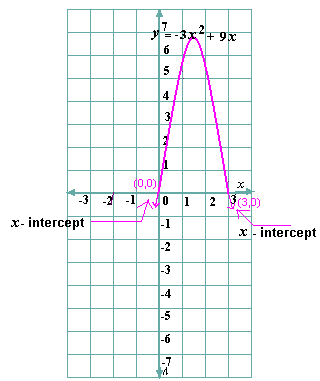
A. 0 and 1
B. 1 and 2
C. 0 and 2
D. 0 and 3
Step: 1
The x y a x b x c a x b x c
Step: 2
The graph intersects the x
Step: 3
So, 0 and 3 are the solutions of the equation.
Correct Answer is : 0 and 3
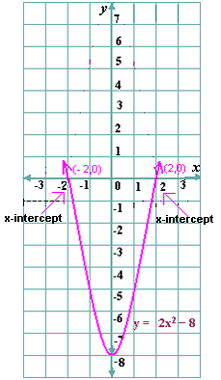
A. 4 and - 4
B. 2 and - 2
C. 5 and - 5
D. 3 and - 3
Step: 1
2x y x
Step: 2
The graph intersect the x
Step: 3
From the graph, the x
[Estimate the values of the x
Step: 4
2(- 2) 2 - 8 =0
[Substitute x x
Step: 5
0 = 0
[Simplify.]
Step: 6
2(2) 2 - 8 =0
[Substitute x x
Step: 7
0 = 0
[Simplify.]
Step: 8
Both the values satisfy the equation.
Step: 9
So, 2 and - 2 are the solutions of the equation.
Correct Answer is : 2 and - 2
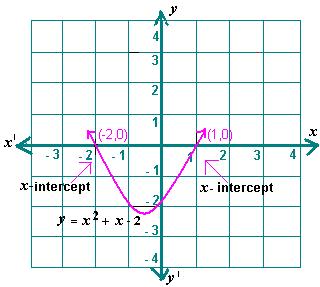
A. - 1 and 1
B. - 3 and 1
C. - 4 and 1
D. - 2 and 1
Step: 1
[The equation in standard form.]
Step: 2
[Original equation.]
Step: 3
[Subtract 2 from each side.]
Step: 4
Sketch the graph of the related quadratic equation y x x
Step: 5
From the graph, x
Step: 6
(- 2) 2 + (- 2) - 2 = 0
[Substitute x
Step: 7
0 = 0
[Simplify.]
Step: 8
(1)2 + 1 - 2 = 0
[Substitute x
Step: 9
0 = 0
[Simplify.]
Step: 10
The values x x x
Step: 11
So, - 2 and 1 are the roots of the equation.
Correct Answer is : - 2 and 1
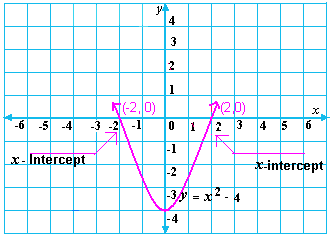
A. - 5 and 5
B. - 4 and 4
C. - 2 and 2
D. - 3 and 3
Step: 1
[The equation in standard form.]
Step: 2
5x
[Original equation.]
Step: 3
5x
[Subtract 20 from each side.]
Step: 4
[Divide by 5 on each side.]
Step: 5
Sketch the graph of the related quadratic function, y x
Step: 6
From the graph, x
Step: 7
(- 2) 2 - 4 = 0
[Substitute x
Step: 8
0 = 0
[Simplify.]
Step: 9
(2) 2 - 4 = 0
[Substitute x
Step: 10
0 = 0
[Simplify.]
Step: 11
Both the values x x x
Step: 12
So, the solutions of the equation are - 2 and 2.
Correct Answer is : - 2 and 2
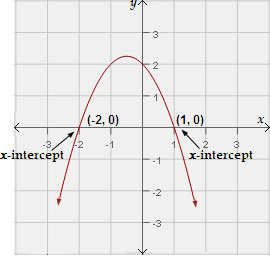
A. - 3 and 1
B. - 4 and 1
C. - 2 and 1
D. - 2 and - 3
Step: 1
[The equation in standard form.]
Step: 2
- 4x x
[Original equation.]
Step: 3
- x x
[Divide each side by 4.]
Step: 4
Sketch the graph of the related quadratic function, y x x
Step: 5
From the graph, x
Step: 6
- (- 2) 2 - (- 2) + 2 = 0
[Substitute x
Step: 7
0 = 0
[Simplify.]
Step: 8
- (1) 2 - (1) + 2 = 0
[Substitute x
Step: 9
0 = 0
[Simplify.]
Step: 10
Both the values x x
Step: 11
So, the solutions of the equation are - 2 and 1.
Correct Answer is : - 2 and 1
A. 1
B. 1.5
C. 5.50
D. 0.50
Step: 1
[Original equation.]
Step: 2
0 = - 16t t
[Replace h
Step: 3
[Substitute a b c
Step: 4
[Simplify.]
Step: 5
[Simplify inside the radical.]
Step: 6
[Simplify the radical.]
Step: 7
[Since t
Correct Answer is : 0.50
A. 6.50
B. 7
C. 7.25
D. 6.75
Step: 1
[Original equation.]
Step: 2
0 = - 16t
[Replace h
Step: 3
[Substitute the values in the quadratic formula: a b c
Step: 4
= 0 ± ( 0 + 4 6 6 5 6 ) - 3 2
[Simplify.]
Step: 5
= 0 ± 4 6 6 5 6 - 3 2
[Simplify inside the radical.]
Step: 6
= 0±216 -32
[Simplify.]
Step: 7
= -216 -32
[Since t
Correct Answer is : 6.75
A. 12 cm
B. 8 cm
C. 14 cm
D. None of the above
Step: 1
Let x x
Step: 2
The area of a triangle = 1 2
Step: 3
48 = 1 2 x x
[Substitute the values.]
Step: 4
48 = 1 2 x x
[Distributive property.]
Step: 5
96 = (x x
[Multiply throughout by 2.]
Step: 6
[Subtract 96 from the two sides of the equation.]
Step: 7
(x x
[Factor.]
Step: 8
Therefore, x
Step: 9
Reject the negative solution, as the length cannot be negative.
So,x x
So,
Step: 10
So, the length of the base of the triangle is 12 cm.
Correct Answer is : 12 cm
A. - 3 and 7
B. - 2 and 1
C. - 3 and 6
D. 2 and 1
Step: 1
[Original equation.]
Step: 2
[Subtract 2 from each side.]
Step: 3
Sketch the graph of the related quadratic function y x x
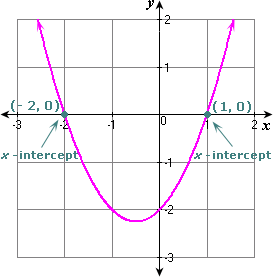

Step: 4
From the graph, the x
[Estimate the values of the x
Step: 5
So, - 2 and 1 are the solutions of the equation.
Correct Answer is : - 2 and 1
- Solving One-Step Linear Equations-Algebra1-Solved Examples
- Solving Two-Step Linear Equations-Algebra1-Solved Examples
- Solving One-Step Linear Inequalities-Algebra1-Solved Examples
- Graphing Linear Equations and Inequalities-Algebra1-Solved Examples
- Solving and Graphing Absolute Value Equations-Algebra1-Solved Examples
- Solving and Graphing Absolute Value Inequalities-Algebra1-Solved Examples
- Identifying the Graph for the Table-Algebra1-Solved Examples
- Solving Systems of Equations using Elimination Method-Algebra1-Solved Examples
- Solving Systems of Equations using Substitution Method-Algebra1-Solved Examples
- Solving Systems of Equations Graphically-Algebra1-Solved Examples
- Graphing Systems of Equations and Inequalities-Algebra1-Solved Examples
- Solving Quadratic Equations By Completing Squares-Algebra1-Solved Examples
- Solving Quadratic Equations by Finding Square Roots-Algebra1-Solved Examples
- No real Solutions for Quadratic Equations-Algebra1-Solved Examples
- Solving Quadratic Linear Systems of Equations-Algebra1-Solved Examples
Related Worksheet
- Quadratic Equation